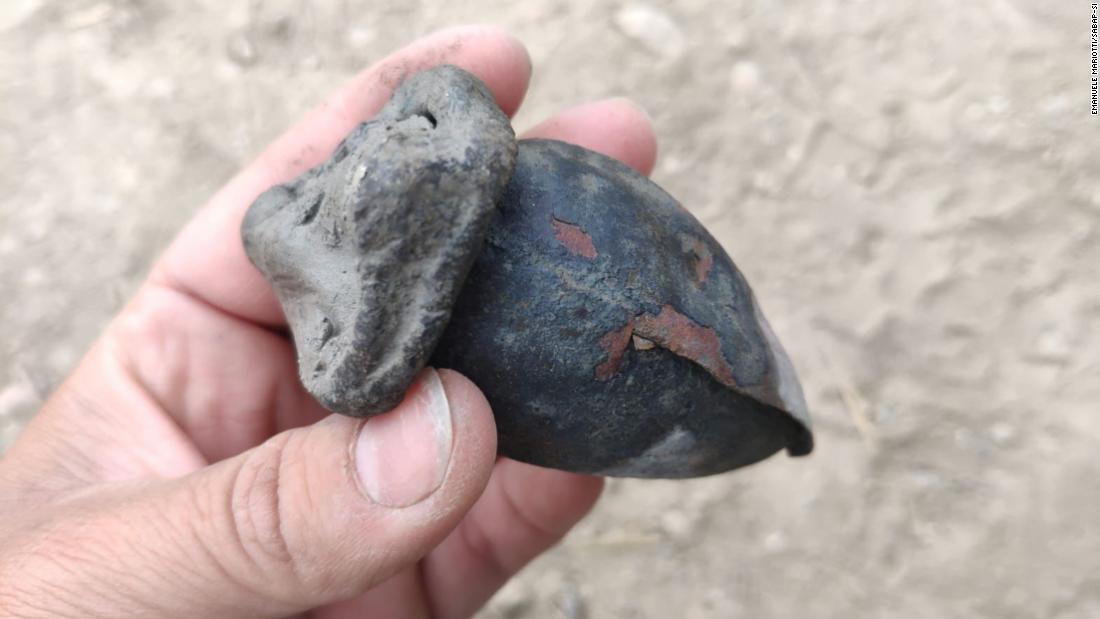Archaeologists make new discoveries at San Casciano dei Bagni in Tuscany
San Casciano’s modern facilities are just a few meters from an ancient site currently the focus of excavations. These thermal baths are a network of sacred pools established by the pre-Italian Etruscans as early as the 4th century BC. and later made more lavish by the ancient Romans, at a time when health and faith were closely linked.
Local archaeologists last week unearthed a treasure trove of artifacts and relics that shed light on the close connection Italy’s past civilizations had with the “water religion,” or the healing, divine origins of hot spring water.
A votive offering to the gods cast in bronze in the form of a womb. Recognition: Emanuele Mariotti/SABAP-SI
“What makes this site unique in the entire Mediterranean is the exceptional state of conservation and the [evidence] It shows how medicinal hot water practices were considered healing under divine protection,” said archaeologist Jacopo Tabolli, scientific director of the excavation project and professor of Etruscan studies at the University for Foreigners in Siena. “Also, the quantity and quality of objects recovered is amazing – we knew something was down there, but we didn’t expect such a surprise.
Locals of San Casciano have long referred to the site as a “sacred mountain,” Tabolli said, also citing a 16th-century doctor’s account that noted the presence of ancient buildings and a well. A geophysical survey conducted by Tabolli’s team in 2019 indicated the presence of structures at the sources; The following year, ancient pillars were discovered sticking out of a bush, and excavation work began (although it was later halted during the pandemic).
The ancient thermal baths of San Casciano functioned like a hospital clinic, where visitors sought relief from respiratory problems or aching bones. For many, a swim in the water relieved their pain, so after their bath they threw offerings to the gods into the bubbling pools to thank them for their healing. These included tree branches, fragrant pine cones and fruits such as peaches, which were recovered in good condition thanks to the layers of mud that have since covered the site.
Several relics in the form of miniature bronze legs, arms and ears have also been excavated. They were left to thank the gods for healing certain parts of the body, or to draw attention – hence the ear shape – to the prayers of mortals in pain.

A collection of three ear-shaped votive offerings excavated at San Casciano dei Bagni. Recognition: Emanuele Mariotti/SABAP-SI
During Etruscan and Roman times, votive offerings in the form of a womb were usually made of terracotta. A bronze found at San Casciano, which would have been very expensive to commission, is the first of its kind, Tabolli said, and serves as evidence of how important this thermal site was.
“The discoveries tell us much about Italy’s ancient communities,” explained Tabolli, “and advance our exploration of their social, cultural and religious landscape in relation to the sacred nature of hot water.”
The site currently contains an Etruscan pool known as the “Great Bath” at eleven meters long and five meters deep, and five smaller Roman pools, which still pour hot water at about 2,000 gallons per minute. There are ruins of fountains and statues alongside travertine altars to the god of prophecy and medicine, Apollo, the goddess of fertility, Isis, and the goddess of the firstborn, Fortuna Primigenia.

An example of a phallus-shaped offering. Recognition: Emanuele Mariotti/SABAP-SI
The health rituals performed in the thermal baths also included those specifically linked to pregnancy and childbirth. A recovered statue of a naked baby led archaeologists to believe that ancient women visited San Casciano both during their pregnancy and after childbirth in hopes of protecting their baby’s health. Similar practices have continued down the centuries since: “Up until 50 years ago, village women who were having trouble conceiving a child would come to the thermal baths believing that the water would relax their wombs,” Tabolli said.
The number of coins made of bronze, silver and orichalcum — a precious metal to which the Romans attributed mystical powers — found in the great bath is also extraordinary, Tabolli said. It is the largest collection of ancient currencies associated with hot springs in the Mediterranean and is also unique for its perfect state of preservation. The coins have retained their original coloring thanks both to the chemical properties of the water and to the mud covering that prevented oxidation.
“They’re still shiny brown and shiny yellow — such bright colors have never been found in an excavation site,” Tabolli said. “It’s a miracle.”
A new village museum will soon present the salvaged wonders to the public. Local authorities and experts believe the spa holds more treasures waiting to be discovered, as its deepest muddy layers hide items dating back to Etruscan times.
Archaeologists will continue to work at the site, and Tabolli is excited to see what might come to light next. “I hope to excavate the Founding Shrine in its entirety,” Tabolli said. “We can already see a pre-Roman layer.”


Comments are closed.